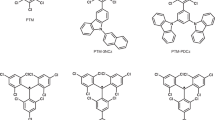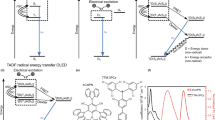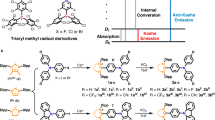Abstract
The doublet-spin nature of radical emitters is advantageous for applications in organic light-emitting diodes, as it avoids the formation of triplet excitons that limit the electroluminescence efficiency of non-radical emitters. However, radicals generally show low optical absorption and photoluminescence yields. Here we explain the poor optical properties of radicals based on alternant hydrocarbons, and establish design rules to increase the absorption and luminescence yields for donor–acceptor-type radicals. We show that non-alternant systems are necessary to lift the degeneracy of the lowest energy orbital excitations; moreover, intensity borrowing from an intense high-lying transition by the low-energy charge-transfer excitation enhances the oscillator strength of the emitter. We apply these rules to design tris(2,4,6-trichlorophenyl)methyl–pyridoindolyl derivatives with a high photoluminescence quantum yield (>90%). Organic light-emitting diodes based on these molecules showed a pure-red emission with an over 12% external quantum efficiency. These insights may be beneficial for the rational design and discovery of highly luminescent doublet emitters.
This is a preview of subscription content, access via your institution
Access options
Access Nature and 54 other Nature Portfolio journals
Get Nature+, our best-value online-access subscription
$29.99 / 30 days
cancel any time
Subscribe to this journal
Receive 12 print issues and online access
$259.00 per year
only $21.58 per issue
Buy this article
- Purchase on Springer Link
- Instant access to full article PDF
Prices may be subject to local taxes which are calculated during checkout



Similar content being viewed by others
References
Baldo, M. A. et al. Highly efficient phosphorescent emission from organic electroluminescent devices. Nature 395, 151–154 (1998).
Ma, Y., Zhang, H., Shen, J. & Che, C. Electroluminescence from triplet metal–ligand charge-transfer excited state of transition metal complexes. Synth. Met. 94, 245–248 (1998).
Adachi, C., Baldo, M. A., Thompson, M. E. & Forrest, S. R. Nearly 100% internal phosphorescence efficiency in an organic light-emitting device. J. Appl. Phys. 90, 5048–5051 (2001).
Uoyama, H., Goushi, K., Shizu, K., Nomura, H. & Adachi, C. Highly efficient organic light-emitting diodes from delayed fluorescence. Nature 492, 234–238 (2012).
Kido, J. & Lizumi, Y. Fabrication of highly efficient organic electroluminescent devices. Appl. Phys. Lett. 73, 2721–2723 (1998).
Di, D. et al. Efficient triplet exciton fusion in molecularly doped polymer light‐emitting diodes. Adv. Mater. 29, 1605987 (2017).
Awaga, K. & Maruyama, Y. Ferromagnetic and antiferromagnetic intermolecular interactions of organic radicals, α‐nitronyl nitroxides. II. J. Chem. Phys. 91, 2743–2747 (1989).
Banister, A. J. et al. Spontaneous magnetization in a sulfur–nitrogen radical at 36 K. Angew. Chem. Int. Ed. 35, 2533–2535 (1996).
Nakahara, K. et al. Rechargeable batteries with organic radical cathodes. Chem. Phys. Lett. 359, 351–354 (2002).
Wang, Y. et al. 1-Imino nitroxide pyrene for high performance organic field-effect transistors with low operating voltage. J. Am. Chem. Soc. 128, 13058–13059 (2006).
Wei, P., Oh, J. H., Dong, G. & Bao, Z. Use of a 1H-benzoimidazole derivative as an n-type dopant and to enable air-stable solution-processed n-channel organic thin-film transistors. J. Am. Chem. Soc. 132, 8852–8853 (2010).
Bin, Z., Duan, L. & Qiu, Y. Air stable organic salt as an n-type dopant for efficient and stable organic light-emitting diodes. ACS Appl. Mater. Interfaces 7, 6444–6450 (2015).
Zhang, Z., Chen, P., Murakami, T. N., Zakeeruddin, S. M. & Grätzel, M. The 2,2,6,6‐tetramethyl‐1‐piperidinyloxy radical: an efficient, iodine‐free redox mediator for dye‐sensitized solar cells. Adv. Funct. Mater. 18, 341–346 (2008).
Jiao, Y. et al. A supramolecularly activated radical cation for accelerated catalytic oxidation. Angew. Chem. Int. Ed. 55, 8933–8937 (2016).
Gamero, V. et al. [4-(N-carbazolyl)-2,6-dichlorophenyl]bis(2,4,6-trichlorophenyl) methyl radical an efficient red light-emitting paramagnetic molecule. Tetrahedron Lett. 47, 2305–2309 (2006).
Velasco, D. et al. Red organic light-emitting radical adducts of carbazole and tris(2,4,6-trichlorotriphenyl)methyl radical that exhibit high thermal stability and electrochemical amphotericity. J. Org. Chem. 72, 7523–7532 (2007).
Heckmann, A., Lambert, C., Goebel, M. & Wortmann, R. Synthesis and photophysics of a neutral organic mixed-valence compound. Angew. Chem. Int. Ed. 43, 5851–5856 (2004).
Heckmann, A. & Lambert, C. Neutral organic mixed-valence compounds: synthesis and all-optical evaluation of electron-transfer parameters. J. Am. Chem. Soc. 129, 5515–5527 (2007).
Blasi, D., Nikolaidou, D. M., Terenziani, F., Ratera, I. & Veciana, J. Excimers from stable and persistent supramolecular radical-pairs in red/NIR-emitting organic nanoparticles and polymeric films. Phys. Chem. Chem. Phys. 19, 9313–9319 (2017).
Peng, Q., Obolda, A., Zhang, M. & Li, F. Organic light‐emitting diodes using a neutral π radical as emitter: the emission from a doublet. Angew. Chem. Int. Ed. 54, 7091–7095 (2015).
Ai, X. et al. Efficient radical-based light-emitting diodes with doublet emission. Nature 563, 536–540 (2018).
Neier, E. et al. Solution-processed organic light-emitting diodes with emission from a doublet exciton; using (2,4,6-trichlorophenyl)methyl as emitter. Org. Electron. 44, 126–131 (2017).
Hattori, Y., Kusamoto, T. & Nishihara, H. Luminescence, stability, and proton response of an open‐shell (3,5‐dichloro‐4‐pyridyl)bis(2,4,6‐trichlorophenyl) methyl radical. Angew. Chem. Int. Ed. 53, 11845–11848 (2014).
Hattori, Y., Kusamoto, T. & Nishihara, H. Enhanced luminescent properties of an open-shell (3,5-dichloro-4-pyridyl)bis(2,4,6-trichlorophenyl)methyl radical by coordination to gold. Angew. Chem. Int. Ed. 54, 3731–3734 (2015).
Kimura, S. et al. A luminescent organic radical with two pyridyl groups: high photostability and dual stimuli-responsive properties, with theoretical analyses of photophysical processes. Chem. Sci. 9, 1996–2007 (2018).
Guo, H. et al. High stability and luminescence efficiency in donor–acceptor neutral radicals not following the Aufbau principle. Nat. Mater. 18, 977–984 (2019).
Diez‐Cabanes, V. et al. Design of perchlorotriphenylmethyl (PTM) radical‐based compounds for optoelectronic applications: the role of orbital delocalization. ChemPhysChem 19, 2572–2578 (2018).
He, C., Li, Z., Lei, Y., Zou, W. & Suo, B. Unraveling the emission mechanism of radical-based organic light-emitting diodes. J. Phys. Chem. Lett. 10, 574–580 (2019).
Dewar, M. & Longuet-Higgins, H. The electronic spectra of aromatic molecules I: benzenoid hydrocarbons. Proc. Phys. Soc. A. 67, 795 (1954).
Longuet-Higgins, H. & Pople, J. A. The electronic spectra of aromatic molecules IV: excited states of odd alternant hydrocarbon radicals and ions. Proc. Phys. Soc. A. 68, 591–600 (1955).
Pople, J. A. Electron interaction in unsaturated hydrocarbons. Trans. Faraday Soc. 49, 1375–1385 (1953).
Pople, J. A. The electronic spectra of aromatic molecules II: a theoretical treatment of excited states of alternant hydrocarbon molecules based on self-consistent molecular orbitals. Proc. Phys. Soc. Lond. A 68, 81 (1955).
Pariser, R. & Parr, R. G. A. A semi-empirical theory of the electronic spectra and electronic structure of complex unsaturated molecules. I. J. Chem. Phys. 21, 466–471 (1953).
Pariser, R. Theory of the electronic spectra and structure of the polyacenes and of alternant hydrocarbons. J. Chem. Phys. 24, 250–268 (1956).
Dong, S. et al. Effects of substituents on luminescent efficiency of stable triaryl methyl radicals. Phys. Chem. Chem. Phys. 20, 18657–18662 (2018).
Franco, C. et al. Operative mechanism of hole-assisted negative charge motion in ground states of radical–anion molecular wires. J. Am. Chem. Soc. 139, 686–692 (2017).
Hele, T. J. H. et al. Anticipating acene-based chromophore spectra with molecular orbital arguments. J. Phys. Chem. A 123, 2527–2536 (2019).
Robinson, G. W. Intensity enhancement of forbidden electronic transitions by weak intermolecular interactions. J. Chem. Phys. 46, 572–585 (1967).
Li, W. et al. A hybridized local and charge-transfer excited state for highly efficient fluorescent OLEDs: molecular design, spectral character and full exciton utilization. Adv. Opt. Mater. 2, 892–901 (2014).
Armet, O. et al. Inert carbon free radicals. 8. Polychlorotriphenylmethyl radicals: synthesis, structure, and spin-density distribution. J. Phys. Chem. 91, 5608–5616 (1987).
Fox, M. A., Gaillard, E. & Chen, C. C. Photochemistry of stable free radicals: the photolysis of perchlorotriphenylmethyl radicals. J. Am. Chem. Soc. 109, 7088–7094 (1987).
Dong, S. et al. Multicarbazolyl substituted TTM radicals: red-shift of fluorescence emission with enhanced luminescence efficiency. Mater. Chem. Front. 1, 2132–2135 (2017).
Murawski, C. et al. Efficiency roll-off in organic light-emitting diodes. Adv. Mater. 25, 6801–6827 (2013).
Giebink, N. C. & Forrest, S. R. Quantum efficiency roll-off at high brightness in fluorescent and phosphorescent organic light emitting diodes. Phys. Rev. B 77, 235215 (2018).
Neese, F. The ORCA program system. WIREs Comput. Mol. Sci. 2, 73–78 (2012).
Acknowledgements
A.A., Q.P., M.Z. and F.L. are grateful for financial support from the National Natural Science Foundation of China (grant nos 51925303, 91833304 and 61935017), the National Key R&D Programme of China (grant no. 2016YFB0401001) and the programme ‘JLUSTIRT’ (grant no. 2019TD-33). T.J.H.H. thanks Jesus College, Cambridge, for a Research Fellowship. J.Z. and Q.G. thank the China Scholarship Council for PhD scholarship (no. 201503170255). R.H.F. and E.W.E. thank EPSRC for funding this work (EP/M005143/1). E.W.E, also acknowledges support from the Leverhulme Trust and Newton Trust. F.L. is an academic visitor at the Cavendish Laboratory, Cambridge, and is supported by the Talents Cultivation Programme (Jilin University, China).
Author information
Authors and Affiliations
Contributions
A.A. and M.Z. designed, synthesized and characterized the luminescent radicals. A.A., Q.G., J.Z., Q.P., F.L. and E.W.E. optimized the devices. T.J.H.H. and E.W.E. devised the theoretical treatment and performed the electronic-structure calculations. R.H.F., F.L. and E.W.E. conceived the project, supervised the work and wrote the manuscript with input from all the authors.
Corresponding authors
Ethics declarations
Competing interests
The authors declare no competing interests.
Additional information
Publisher’s note Springer Nature remains neutral with regard to jurisdictional claims in published maps and institutional affiliations.
Supplementary information
Supplementary Information
Supplementary Sections 1–19 including Figs. 1–24, Tables 1–5 and discussion.
Rights and permissions
About this article
Cite this article
Abdurahman, A., Hele, T.J.H., Gu, Q. et al. Understanding the luminescent nature of organic radicals for efficient doublet emitters and pure-red light-emitting diodes. Nat. Mater. 19, 1224–1229 (2020). https://doi.org/10.1038/s41563-020-0705-9
Received:
Accepted:
Published:
Issue Date:
DOI: https://doi.org/10.1038/s41563-020-0705-9
This article is cited by
-
Accelerated discovery of molecular nanojunction photocatalysts for hydrogen evolution by using automated screening and flow synthesis
Nature Synthesis (2024)
-
Enabling nonconjugated polyesters emit full-spectrum fluorescence from blue to near-infrared
Nature Communications (2024)
-
A Stable Open-Shell Conjugated Diradical Polymer with Ultra-High Photothermal Conversion Efficiency for NIR-II Photo-Immunotherapy of Metastatic Tumor
Nano-Micro Letters (2024)
-
A highly efficient open-shell singlet luminescent diradical with strong magnetoluminescence properties
Light: Science & Applications (2023)
-
Mesitylated trityl radicals, a platform for doublet emission: symmetry breaking, charge-transfer states and conjugated polymers
Nature Communications (2023)



